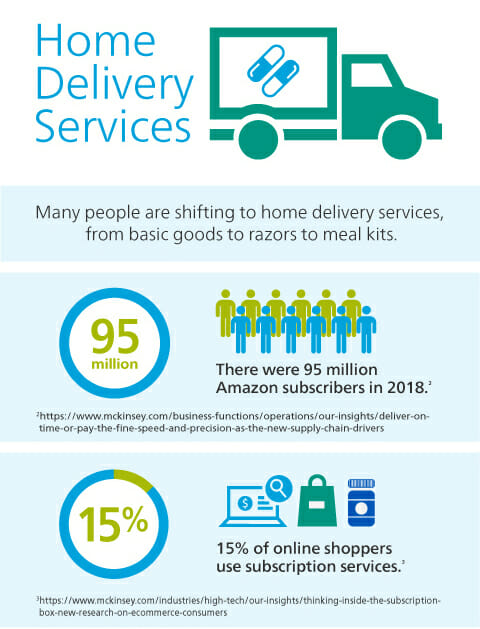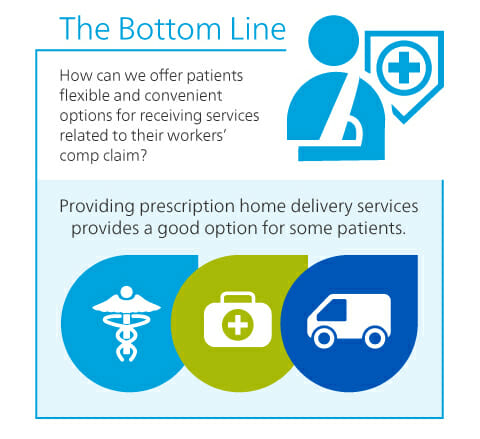Changing Consumer Expectations: Lessons from Home Delivery Services
This article is the second installment of a three-part series examining consumer expectations. To read the first article, click here.
Learning from Amazon and the Surge of Delivery Services
How can the workers' compensation industry learn from other industries in the age of automation and technology? In this article, we will explore the shift to home delivery services and how this shift is relevant to the workers' compensation industry and prescription delivery services. Home delivery services are growing rapidly for consumers. In June 2018, there were 95 million Amazon Prime subscribers in the United States representing approximately 60 percent of the platform’s U.S. customers. Amazon is a major example, but the entire e-commerce and mail delivery industry is continuing to flourish, with more companies entering diverse avenues of delivery services, from box subscriptions to groceries.
Changes in Buying Habits Provide Insight into What Consumers Want
The rise in popularity of Amazon Prime in the past few years underscores what consumers want when making purchases: fast, easy, personalized and reliable services. Recent numbers highlight how much consumers are embracing online shopping and, more specifically, two-day shipping. In just one year, from 2017 to 2018, the number of subscribers to Amazon’s Prime delivery service jumped by 10 million. In a survey of Prime members, the most common reasons for shopping on the site were free shipping, price and two-day or next-day shipping. The increase in subscription boxes over the past five years also sheds light on consumer preferences. According to McKinsey, around 15 percent of online shoppers use subscription mail services and “the subscription e-commerce market has grown by more than 100 percent a year over the past five years.” These services range from meal kits to apparel to vitamins to razors, and are continuing to diversify.
Delivery may not be as instant as driving down the road to pick up groceries or household items, but it allows consumers flexibility in purchasing. Especially for those using subscription services, delivery of goods on a regular basis can cut down on time and stress in getting necessary items. This developing market begs the question: if consumers are expanding their online purchases from clothes to groceries to specialized goods, why would prescriptions be any different?
How the Workers’ Compensation Industry Can Evolve with Changing Consumer Expectations
A Look at Prescription Delivery Services
As more people move to home delivery services, the industry is seeing renewed focus as prescription delivery becomes a topic of discussion. However, the delivery of medications is more nuanced than the delivery of common goods like home decor or electronics. It is a very personal experience, especially when the patient needs a medication to manage pain or an ongoing condition. Patients rely upon these medications and are often used to picking up their prescriptions in a traditional pharmacy. Knowing that their prescriptions will be there when they need them is vital. Therefore, there could be hesitation in moving to a less-traditional method of receiving medications, especially when relying on shipping times. There are also considerations around medical safety. When a patient visits a pharmacy, he or she can discuss the medication with a pharmacist and know that they are receiving sound medical advice. Additionally, there may be concern around what may happen to the medication in transport (e.g. if it has been sitting out in hot weather, that could affect its potency). With this in mind, it is no surprise that the adoption of prescription delivery has been slow. However, as consumers continue to adjust to delivery services, they will likely turn to home prescription delivery as well. As we explored in our last article, workers’ compensation patients are just like any other consumer; they participate in new technology and use home delivery services such as Amazon. Although their needs may differ, their expectations of fast, reliable and convenient services are much the same.
As more people move to home delivery services, the workers’ compensation industry can leverage that trend to offer home delivery of prescriptions. Depending on the patient, home delivery services can offer convenience and a better recovery experience. It may also drive adherence, since patients will receive their medications on a regular basis in 90-day quantities, cutting down the amount of times they need to visit a pharmacy to refill. Additionally, technological advances can alleviate concerns about safety and delivery. Listen to our latest podcast to learn more about these types of technologies. Where might home delivery of prescriptions work the best? In rural areas, where healthcare access is sparser, patients can receive their prescriptions without hassle. For those who have experienced severe injuries, getting to a pharmacy may be a difficult task. Home delivery offers larger fill sizes, fewer visits to a pharmacy and regular delivery times, ensuring that patients receive the proper care when they need it. Overall, prescription delivery may not be the best fit for every patient, but as more consumers subscribe to home delivery services, it is important to consider how to accommodate this demand.
Questions to Ask
As consumers move more toward home delivery services and consider prescription delivery, how can you best prepare? Consider the following questions:
- Are your patients looking for more flexible options to receive their prescriptions?
- Do you have any rural patients looking for easier ways to receive their prescriptions?
- Are any patients better suited to regular prescription deliveries?
- How can your organization adapt to the ongoing shift toward home delivery services?
- Are your business partners providing you flexible and robust delivery options for your patients?
Home delivery services are sure to continue growing in upcoming years as consumers continue to adopt this convenient way to receive necessary items.



